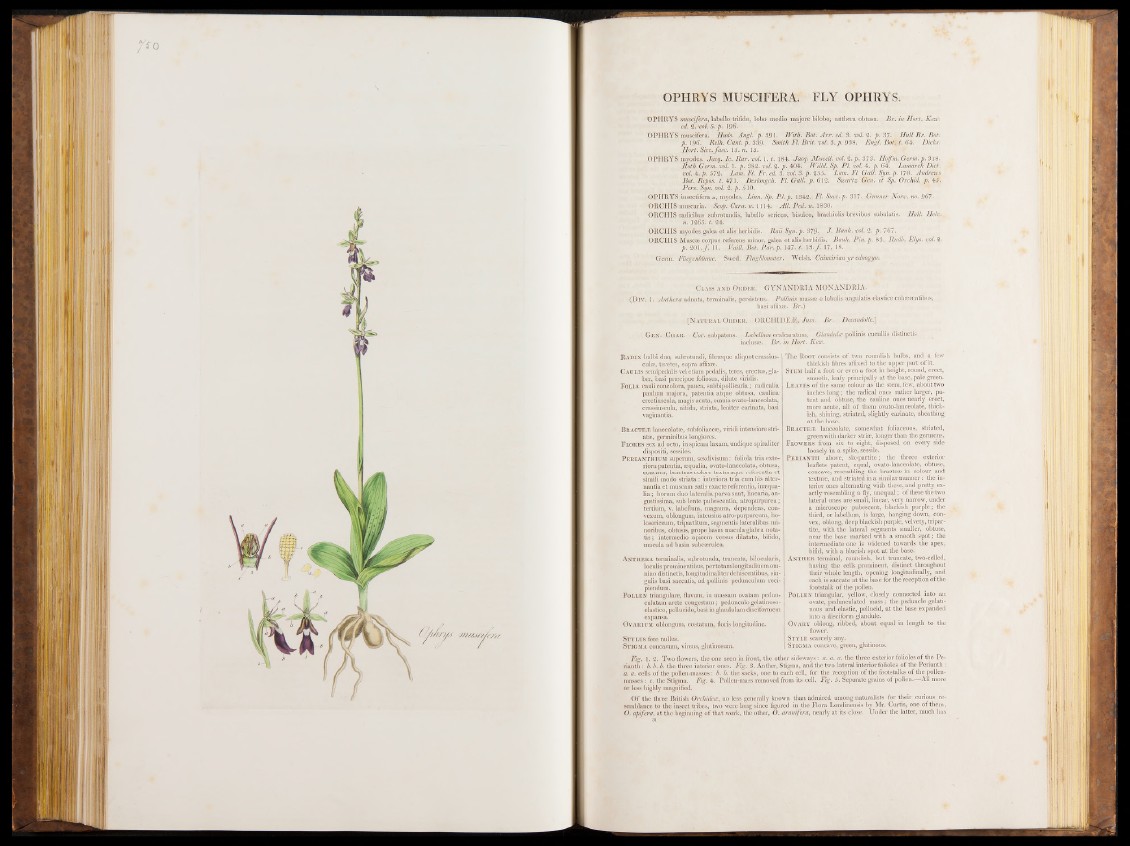
OPHRYS MUSCIFERA. FLY OPIIRYS.
OPHRYS muscifera, labeilo trifidOj lobo medio majore bilobo; ailthera obtusa: B r . in Hort. Kero:
ed. 2. vol. 5. p: 196.
OPHRYS muscifera. Huds. Angl. p. 391. With. Bot. A rr. ed. 3: vol. 2. p. 37. ITull B r . Bot:
p. 196. Relh. Cant. p. 339-, Smith FI. B rit, vol: 3.p\ 938. Engl. Bot: t. 64. Dicksi
Hort. S icc.fasc. 15. n. 15.
OPHRYS myodes. Jacq..Ic. Bar. vol. 1 .1. 184. Jacqx MiscclL vol. 2. p. 373. Iloffm. Ger?n.p. 3l3.
Roth Germ. vol. 1. p. 382. vol. 2. p. 404. Willd. Sp. Pi. vol. 4. p. 64. Lamarck Diet,
vol. 4. p. 572. Lam. FI. Fr. ed. 3. vol. 3. p. 255. Lam. Fl. Gall-. Syn. p. 170. Andrews
Bot. Repos, t. 471. Deslongch. Fl. Gall. p. 612. Swartz Gen. el Sp. Orchid, p . 45.
Pers. Syn. vol. 2. p. 510.
OPHRYS insectifera «, myodes. Linn. Sp. P i. p. 1342. Fl. Succi p. 317. Gunner Norv no. 967.
ORCHIS muscariai Scop. Cam. n. 1114. All. Ped. n. .1830. •
ORCHIS radicibus subrotundis, labeilo sericeo, bisulco, brachiolis brevib'us subulatis. Hall: Helv:
h. 1265. ti 24.
ORCHIS myodes galea et alls herbidis. Rail Syn. p. 379-, J- Barth, vol. 2. p. 767.
ORCHIS Muscse corpus referens minor, galea et alis herbidis. Bauh. Pin. p. 83. Rudb. Elys. vol. 2;
p . 201. ƒ 11. VailL Bot. Par. p. 147. t. \ 3 i f . \7, 18.
Germ. Fliegcnblumc. Swed.' Flugblomster. Welsh. Caineirian y r ednogyri:
Class ANC Order. G Y N A N D R IA MONANDRIA.
(D iv. 1. Anthera adnata, terminalis, persistens. Pollinis massæ e lobulis angulatis élastice cohærentibusj
basi affixæ. B r .)
. [N atural Order. OR C IIID EÆ , J uss. B r . Decandolle.]
Ge n . Char. Cot..subpatens. Labcllum ecalcaratum. Glandulce pollinis cucullis distinctis
inclusæ.. B r . in H ort. Kero.
Radix bulbi duo, subrotandi, fibræque aliquot crassius-
' cube, teretes, supra affixæ.
Caulis semipedalis vel etiam pedalis, teres, erectus, gla-
ber, basi præcipue foliosus, dilute viridis.
Folia cauli concolora, pauca, subbipollicaria ; radicalia
paul.um majora, patentia atque obtusa, caulina'
erectiuscula, magis acuta, omnia ovato-lanceolata,
crassiuscula, nitida, striata, leniter carinata, basi
vaginantià.
Bracteæ lanceolatæ,' subfoliaceæ, viridi intensiore stri-
atæ, germinibus longiores.
Flores sex ad octo, in spicam laxam, undique spiraliter
dispositi, sessiles.
Perianthium superum, sexdivisum : foliola tria exte-
riora patentia, æqualia, ovato-lanceolata, obtusa,
concava, bracteas colore texturaque referenda et
simili modo striata : interiora tria cum his alter-
nantia et muscam satis exacte referentia, inæqua-
lia ; horum duo lateralia parva sunt, linearia, an-
gustissima, sub lente pubescentia, atropurpurea ;
tertium, v. labellum, magnum, dependens, con-
vexum, oblongum, intensius atro-purpureum, ho-
losericeum, tnpartitum, segmentis.lateralibus mi-
noribus, obtusis, prope basin macula glabra nota-
tis; intermedio apicem versus dilatato, bifido,
macula ad basin subcærulea.
Anthera terminalis, subrotunda, truncata, bilocularis,
loculis proininentibus, per totam longitudinem om-
nino distinotis, longitudinaliter dehiscentibus, singulis
basi saccatis, ad pollinis pedunculum recipiendum.
Pollen trianguläre, flavum, in massam ovatam pedun-
culatam arete congestum ; pedunculo gelatinoso-
elastico, pellucido, basi in glandulam disciformem
expansa.
Ovarium oblongum, costatum, floris longitudine.
Stylus fere nullus.
Stigma concavum, virens, glutinosum.
The Root consists of two roundish bulbs, arid a few
thickish fibres affixed to the upper part of it.
Stem half a foot or even a foot in height, round, erect,
smooth, leafy principally at the base, pale green.
Leaves of the same colour as the stem, few, about two
inches long; the radical ones rather larger, patent
and obtuse, the cauline ones nearly erect,
more acute, all of them ovato-lanceolate, thickish,
shining, striated, slightly carinate, sheathing
at the base.
Bracteje lanceolate, somewhat foliaceous, striated,
green with darker strife, longer than the germens.
Flowers from six to eight, disposed on every side
loosely in a spike, sessile.
Perianth above, six-partite; the threee exterior
leaflets patent, equal, ovato-lanceolate, obtuse,
concave, resembling the bracteas in colour and
texture, and striated in a similar manner: the interior
ones alternating with these, and pretty ex-
actfyresembling a fly, unequal; of these the two
lateral ones are small, linear, very narrow, under
a microscope pubescent, blackish purple; the
third, orlabeljum, is large, hanging down, convex,
oblong, deep blackish purple, velvety, tripartite,
with the lateral segments smaller, obtuse,
near the base marked with a smooth spot; the
intermediate one is widened towards the apex,
bifid, with a blueish spot at the base.
Anther terminal, roundish, but truncate, two-celled,
having the cells prominent, distinct throughout
their whole length, opening longitudinally, and
each is saccate at the base for the reception of the
footstalk of the pollen.
Pollen triangular, yellow, closely connected into an
ovate, pedunculated mass; the peduncle gelatinous
and elastic, pellucid, at the base expanded
into a disciform glandule.
Ovary oblong, ribbed, about equal in length to the
flower. •
Style scarcely any.
Stigma concave, green, glutinous.
Fig. 1. 2. Two flowers, the one seen in front, the other sideways: a. a. a. the three exterior folioles of the Perianth
: b. b. b. the three interior ones. Fig. 3. Anther, Stigma, and the two lateral interior folioles of the Perianth :
a. a. cells of the pollen-masses : b. b. the sacks, one to each cell, for the reception of the footstalks of the pollen-
masses : c. the Stigma. Fig. 4. Pollen-mass removed from its cell. Fig. 5. Separate grains of pollen.—All more
or less highly magnified.
Of the three British Orchidea, no less generally known than âdmired among naturalists for their curious resemblance
to the insect tribes, two were long since figured in the Flora Londinensis by Mr. Curtis, one of them,
O. apifera, a t the beginning of that work, the other, O. aranifera, nearly a t its close. Under the latter, much has